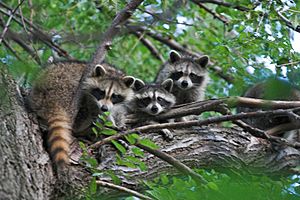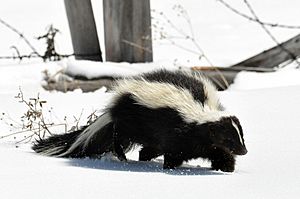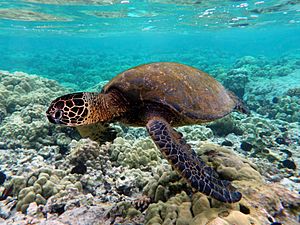Fauna of the United States facts for kids
The fauna of the United States of America means all the amazing animals that live in the Continental United States, its surrounding oceans and islands, the Hawaiian Islands, Alaska in the Arctic, and other island territories in the Pacific and Caribbean. The U.S. is home to many endemic species, which means they are found nowhere else on Earth.
The U.S. is part of the Nearctic, Neotropic, and Oceanic animal regions. This means it shares many plants and animals with the rest of North and South America.
About 432 different kinds of mammals live in the continental U.S. Some common animals found in all of the lower 48 states include the white-tailed deer, bobcat, raccoon, muskrat, striped skunk, barn owl, American mink, American beaver, North American river otter, and red fox. The red-tailed hawk is a very common hawk across the U.S. and all of the Americas.
Many large areas with unique wildlife are protected as national parks. In 2013, the U.S. had over 6,770 national parks or protected areas. These areas covered more than 1,006,619 square miles (2,607,131 km2).

Contents
Animals of the Western United States
The Western United States has many different types of environments and animals. You can find everything from sand dunes in the Great Basin Desert (which covers much of Nevada) to huge glaciers in Washington state.
Forests in Northern California, Oregon, Washington, Idaho, and Montana have animals that like temperate climates. But Southern California, Nevada, Arizona, southern Utah, and New Mexico are dry deserts. Animals there are used to very hot and cold temperatures.
The West Coast climate changes from cold in the north to warm in the south. Not many species live along the entire West Coast. However, the American Bald Eagle does. It lives from the Aleutian Islands in Alaska to the California Channel Islands.
In most of the Western U.S., you can find mule deer, white-tailed antelope squirrels, cougars, American badgers, coyotes, hawks, and many kinds of snakes and lizards.
While the American black bear lives all over the U.S., brown bears and grizzly bears are more common in the northwest and Alaska. Along the West Coast, you can see different types of whales, sea otters, California sea lions, and northern elephant seals.
The dry deserts of California, Nevada, Arizona, and New Mexico are home to some of the world’s most venomous lizards, snakes, and scorpions. The Gila monster and Mohave rattlesnake are well-known examples. The Sonoran Desert has eleven types of rattlesnakes, more than anywhere else.
Along the southwestern border, you might find jaguars and ocelots. Other mammals include the Virginia opossum in California and coastal Oregon and Washington. The North American beaver and mountain beaver live in the forests of Washington, Oregon, and Northern California. The kit fox lives in Arizona, New Mexico, and Utah. The gray fox is found throughout the Western U.S.
The red fox mainly lives in Oregon and Washington. The island fox is special because it only lives on six of the eight Channel Islands in Southern California. These islands are also famous for their ocean life and unique animals. These include the Channel Islands spotted skunk, Garibaldi fish, island fence lizard, island scrub jay, and bald eagle. The raccoon and spotted skunk are found across the Western U.S. The ring-tailed cat lives in Arizona, New Mexico, Western Texas, Utah, Colorado, and most of California.
Channel Islands Wildlife
Channel Islands National Park includes five of the eight California Channel Islands. These islands are part of one of the richest ocean areas in the world. Many unique plants and animals are endemic to the Channel Islands. This means they are found only there.
Some of these special animals are the island fox, Channel Islands spotted skunk, island scrub jay, ashy storm-petrel, island fence lizard, island night lizard, Channel Islands slender salamander, Santa Cruz sheep, and San Clemente loggerhead shrike. Other animals on the islands include the California sea lion, California moray, bald eagle, and the Catalina Island bison herd (which were brought there by people).
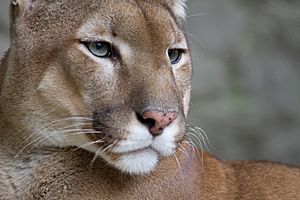
Animals of the Southern United States
The South has many different environments. These include swamps in Louisiana, coastal marshes and pine forests in the Carolinas, hills in Tennessee and Kentucky, desert in Western Texas, mountains in West Virginia, and grasslands in Missouri, Oklahoma, and the Texas Panhandle. Animals found throughout the region include the Virginia opossum and nine-banded armadillo.
The American alligator lives in much of the South. This includes every coastal state from North Carolina to Texas, plus Arkansas. The less common American crocodile is only found in southern Florida. The alligator snapping turtle and over forty other types of turtles live in the swamps of the southern U.S. The coypu is an animal that was brought here and also lives well in swampy areas. Other animals that thrive in southern wetlands include the Carolina anole, razor-backed musk turtle, and broad-headed skink.
The gray and red fox are found throughout the South. The swift fox lives in northern Texas and Oklahoma. Other mammals include the American black bear, found in woodlands in states like Missouri, Arkansas, Louisiana, Florida, and the Carolinas. The white-tailed deer is found in all southern states.
The Texas longhorn is the official state mammal of Texas. The North American porcupine and American beaver can be found across the South, except for Florida. Rabbits are common in the South. The eastern cottontail is found everywhere. The desert cottontail and black-tailed jackrabbit are mainly in Texas, Oklahoma, and Nebraska. The swamp rabbit lives in wetlands in states like Mississippi, Alabama, Louisiana, and Arkansas.
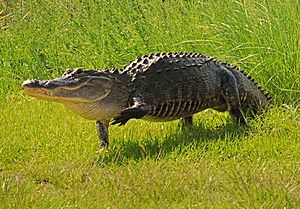
Animals of the Central United States
The American prairie in the Central United States is home to animals that are good at living in grasslands. Native mammals include the American bison, eastern cottontail, black-tailed jackrabbit, plains coyote, black-tailed prairie dog, muskrat, opossum, raccoon, prairie chicken, wild turkey, white-tailed deer, swift foxes, pronghorn antelope, and the Franklin's ground squirrel.
Reptiles include bullsnakes, common collared lizard, common snapping turtle, musk turtles, yellow mud turtle, painted turtle, western diamondback rattlesnake, and the prairie rattlesnake. Some common amphibians are the three-toed amphiuma, green toad, Oklahoma salamander, and plains spadefoot toad. The bald eagle is often seen in the Rocky Mountains and other mountains in the middle of the country.
Rabbits live across the Great Plains. The black-tailed jackrabbit is in Texas, Oklahoma, Nebraska, and Kansas. The white-tailed jackrabbit is in the Dakotas, Minnesota, and Wisconsin. The swamp rabbit is in Texas swamps. The eastern cottontail is found in Texas, Oklahoma, Kansas, Nebraska, the Dakotas, and all Eastern U.S. states.
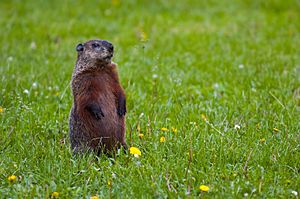
The groundhog is common in Illinois, Iowa, Missouri, and Minnesota. The Virginia opossum is found in states like Missouri, Indiana, Iowa, Oklahoma, Nebraska, and Kansas. The nine-banded armadillo lives across the South and in Missouri, Kansas, and Oklahoma. The muskrat is found throughout the Central U.S., except Texas. The American beaver is in every central state.
The American buffalo is perhaps the most famous animal of the American prairie. They once roamed freely across the Great Plains and were very important to Native American societies. They almost disappeared in the 1800s, but their numbers have grown again. Today, about 200,000 bison live on preserves and ranches.
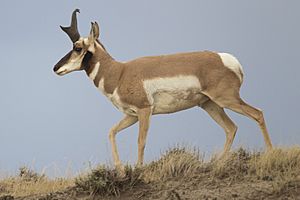
Some animals found in every central state include the red fox, bobcat, white-tailed deer, raccoon, eastern spotted skunk, striped skunk, long-tailed weasel, American badger, and beaver. The wild boar is common in the South. The American mink lives in every central state except Texas. The least weasel is found around the Great Lakes and in states like Nebraska, the Dakotas, Minnesota, Iowa, Illinois, Michigan, and Wisconsin.
The gray fox is found in Iowa, Missouri, Oklahoma, Texas, and around the Great Lakes. The ring-tailed cat is in the southern region, including Texas, Missouri, and Oklahoma. Many types of squirrels live in the central U.S., such as the fox squirrel, eastern gray squirrel, Franklin's ground squirrel, and thirteen-lined ground squirrel. Voles include the prairie vole, woodland vole, and meadow vole. The plains pocket gopher lives across the Great Plains.
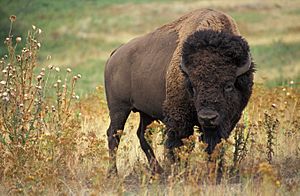
Animals of the Eastern United States
The Appalachian Mountains and the Eastern United States have many animals that live in forests. These include deer, rabbits, rodents, squirrels, hares, woodpeckers, owls, foxes, and bears. The New England region is known for its crabs and the American lobster along the Atlantic Coast. The bobcat, raccoon, and striped skunk live in every eastern state. The American alligator lives in every coastal state from North Carolina to Texas.
Some mammals found throughout the Eastern U.S. are the red fox and gray fox, North American beaver, North American porcupine, Virginia opossum, eastern mole, coyote, white-tailed deer, American mink, North American river otter, and long-tailed weasel. The American black bear lives in most of New England, New York, New Jersey, Pennsylvania, Maryland, the Virginias, and parts of the Carolinas and Florida.
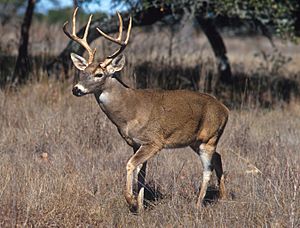
Shrews are common. The cinereus shrew, long-tailed shrew, and American water shrew are widespread in New England. The North American least shrew and southeastern shrew are common in the southeastern states. The American pygmy shrew, smoky shrew, and northern short-tailed shrew are found from the Appalachian Mountains to New England. The star-nosed mole lives across the Eastern U.S. The hairy-tailed mole is more common from the Appalachians north to New England.
Hares are also common. The snowshoe hare lives from the Appalachians to New England. The Appalachian cottontail is only in the Appalachians. The New England cottontail is only in New England. The eastern cottontail is widespread throughout the east. The white-footed mouse and muskrat are common throughout the east, except Florida. The meadow vole is found from the Appalachians to New England.
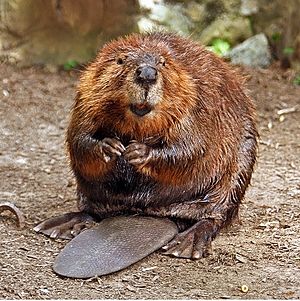
The brown rat and house mouse were brought to the U.S. and now live all over the Eastern U.S. Weasels like the fisher and short-tailed weasel are found in the northeast. The eastern chipmunk, fox squirrel, eastern gray squirrel, and woodchuck are found throughout the region. The southern flying squirrel and northern flying squirrel are more common in the southeast. The American red squirrel is more common in the northeast. The least weasel is native to the Appalachian Mountains.
The wild boar is an ancestor of domestic pigs. It has spread through much of the southeastern region as an invasive species. The Canada lynx is found in parts of New England. Many types of bats live in the east. These include the eastern pipistrelle, silver-haired bat, eastern red bat, hoary bat, big brown bat, and little brown bat.
Along the Atlantic Coast, the harbor seal is the most common seal. Other seals like the hooded seal and grey seal are found in the northwest Atlantic. Many whales are common along the Atlantic coastline. These include the common minke whale, fin whale, sei whale, blue whale, humpback whale, and sperm whale. Dolphins are also common, such as the Risso's dolphin, short-beaked common dolphin, and common bottlenose dolphin.
Several sea turtles live along the Atlantic coast. These include the hawksbill sea turtle, Kemp's ridley sea turtle, and loggerhead sea turtle. The green sea turtle and leatherback sea turtle are more common along the southeastern coastline.
Many land turtles and tortoises are found throughout most of the Eastern United States. These include the common snapping turtle, painted turtle, spotted turtle, diamondback terrapin, and eastern box turtle.
Some snake species found in much of the Eastern U.S. include the eastern racer, timber rattlesnake, eastern hog-nosed snake, milk snake, and common garter snake. Snakes found mostly in the southeast include the eastern diamondback rattlesnake, coral snake, water moccasin, and eastern indigo snake. The eastern fence lizard is common throughout the Eastern United States, except for New York and New England.
The gray wolf once lived in the Eastern U.S., but it is now gone from this area. The eastern cougar was also once widespread but was declared extinct in 2011. Moose once roamed the east but are now only found in northern New England. The sea mink was hunted until it became extinct in 1903.
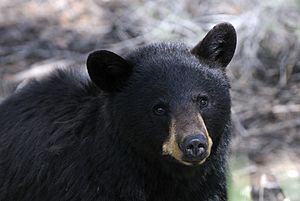
Animals of the Hawaiian Islands
Most of the animals in Hawaii have changed over time to fit their island home. Today, nearly 90% of Hawaii's animals are endemic. This means they live nowhere else on Earth. Kauaʻi has the most tropical birds because it is the only island without mongooses. The Javan mongoose is found on most islands, but not on Lanaʻi and Kauaʻi.
Famous birds include the ʻiʻiwi, nukupuʻu, and Kauaʻi ʻamakihi. The hoary bat is found in Kōkeʻe State Park on Kauaʻi. Wild horses live in the Waipio Valley. Wild cattle live near Mauna Kea. The Australian brush-tailed rock-wallaby lives near the Kalihi Valley on Oʻahu. The Hawaiian monk seal, wild goats, sheep, and pigs live across most of the islands.
In Hawaii, three types of sea turtles are native: honu, honu’ea, and the leatherback sea turtle. Two other types, the loggerhead sea turtle and the olive ridley sea turtle, are sometimes seen in Hawaiian waters.
Animals of Alaska
The wildlife of Alaska is very rich and diverse. It includes polar bears, puffins, moose, bald eagles, Arctic foxes, wolves, Canadian lynx, muskox, snowshoe hare, mountain goats, walrus, and caribou. Alaska has many different environments, from grasslands and mountains to tundra and thick forests.
Alaska also has over 430 types of birds and the largest number of bald eagles in the nation. From tiny pygmy shrews that weigh less than a penny to huge gray whales that weigh 45 tons, Alaska is a "Last Frontier" for animals. Many species that are endangered elsewhere are still common in Alaska.
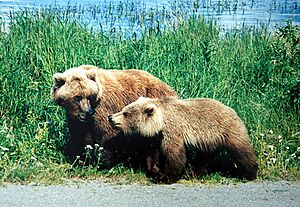
Aleutian Islands Wildlife
The Aleutian Islands are home to many large bird colonies. More than 240 bird species live in Alaska's Aleutian Archipelago. Large seabird colonies are on islands like Buldir Island, which has 21 types of breeding seabirds. These include the red-legged kittiwake, which only lives in the Bering Sea.
The islands are also visited by birds from Asia, such as the common rosefinch and Siberian rubythroat. Other animals in the Aleutian Chain include the Arctic fox, American mink, Porcupine caribou, northern sea otter, horned puffin, tufted puffin, Steller sea lion, and spotted seal.
Animals of U.S. Territories
American Samoa Wildlife
Because American Samoa is so far away, it has fewer types of land animals. But it has a huge variety of animals overall. More than 9,000 acres are part of the National Park of American Samoa. This park covers three of the six islands: Tutuila, Ofu-Olosega, and Ta‘ū. Eight types of mammals have been seen in American Samoa, and none are critically endangered.
The mammals include several native bats, like the Samoa flying fox and insular flying fox. There are 65 types of birds. Some unique ones are the blue-crowned lorikeet, the spotless crake, the many-colored fruit dove, and the wattled honeyeater.
Many reptiles live on the islands, including five types of geckos, eight types of skinks, and two types of snakes: the Pacific boa and the Australoasian blindsnake. The ocean life is amazing, especially around the colorful coral reefs. The Samoan ocean is home to sea turtles like the hawksbill sea turtle, olive ridley sea turtle, leatherback sea turtle, and green sea turtle. Five types of dolphins live here: spinner dolphin, rough-toothed dolphin, bottlenose dolphin, pantropical spotted dolphin, and striped dolphin.
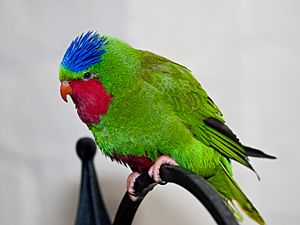
Guam Wildlife
After World War II, the brown tree snake was brought to the island of Guam. This caused many native animals to disappear. Because there were many prey animals and no predators, the brown tree snake population grew very quickly. At one point, there were nearly 13,000 snakes per square mile. Ten out of twelve native bird species, ten lizards, and two bats became extinct because of this snake.
In recent years, the U.S. government has worked hard to reduce the number of brown tree snakes. For example, in 2013, a $1 million program dropped over 2,000 mice filled with poison on the island. In 2013, it was estimated that over two million brown tree snakes were on the island. Other animals brought to Guam include the Philippine deer, Asiatic water buffalo, marine toad, and giant African land snail. Several native types of skinks, geckos, and monitor lizards are still found on the island.
Northern Mariana Islands Wildlife
The Commonwealth of Northern Mariana Islands has 40 types of native and introduced birds. Some unique birds are the Mariana fruit dove, the Mariana swiftlet, the Rota white-eye, and the Tinian monarch. Other common birds that were brought here include the collared kingfisher and the rufous fantail. The Mariana fruit bat lives only on Guam and the Northern Mariana Islands. The sambar deer is the largest mammal and lives on several islands. The monitor lizard, which can be up to 3 feet long, is also on the island of Rota. The oceans are home to over a thousand types of marine life. These include coconut crabs, mahi-mahi, barracuda, tridacna, marlin, and tuna.
Puerto Rico Wildlife
Puerto Rico has 349 bird species, 83 mammals, 25 amphibians, 61 reptiles, and 677 types of fish. Birds found only in Puerto Rico include the Puerto Rican owl, Puerto Rican woodpecker, Puerto Rican tody, and Puerto Rican nightjar. All 13 native land mammals are bats. These include the greater bulldog bat and the Antillean ghost-faced bat. Native mammals that are now extinct include the plate-toothed giant hutia.
Reptiles unique to Puerto Rico include the Puerto Rican boa, the guanica blindsnake, the Mona Island iguana, and the Puerto Rican worm lizard. Amphibians native to the island include the Puerto Rican crested toad and the common coqui. Unique fish include the Puerto Rican snake eel.

Virgin Islands Wildlife
The Virgin Islands National Park covers about 60% of St. John Island and almost all of Hassel Island. The national park has over 140 types of birds, 302 types of fish, 7 types of amphibians, and 22 types of mammals. Several types of sharks, manatees, and dolphins swim in the seas.
See also
In Spanish: Fauna de Estados Unidos para niños


